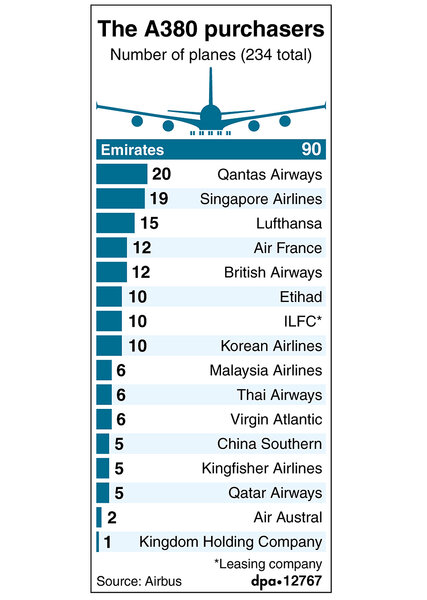Qantas A380 engine emergency casts scrutiny on Airbus superjumbo jets
Loading...
| Paris and Boston
Qantas and Singapore Airlines have grounded their fleets of Airbus A380 airliners after one of the jets operated by Qantas blew out an engine, shooting flames and dropping large metal chunks.
Although the incident ended without injury, it is drawing close scrutiny as the most serious mid-air emergency for the world's largest jetliner, a superjumbo that can seat 525 people.
The trouble aboard the Qantas flight started six minutes after it left Singapore on its way to Sydney. The pilot dumped fuel over Indonesia before returning to Singapore’s Changi Airport. When the jetliner landed, it appeared that casing from its number two engine was missing and parts of the engine were blackened. None of the 433 passengers or 26 crewmembers were hurt.
It was the most serious incident involving an A380 since the launch of the jetliner in 2007. Qantas immediately grounded its fleet of A380s. Singapore Airlines followed suit a few hours later, saying it would conduct technical safety checks on the advice of Airbus and Rolls-Royce, the maker of the Trent 900 engine that failed. Not all A380s use that engine.
Continuing flights
Three other airlines that operate the A380 – Air France, Emirates, and Lufthansa – said they will continue flights as scheduled.
Air safety experts say they expect investigators to determine fairly quickly what caused the engine failure. But at least for now, the incident has raised questions about the safety of A380s using the Trent 900 engines.
"It's very unusual to get an uncontained engine failure," says William Voss, president of the Flight Safety Foundation, a nonprofit group near Washington. "It's serious."
The problem was "uncontained" in that pieces of the engine went flying, some falling to the ground and some apparently puncturing a wing of the aircraft.
Still, Mr. Voss says that advances in engine design make more-severe outcomes unlikely. Latest-generation jet engines tend to be "extremely reliable," he says, even as they use advanced materials to operate at high temperatures and increase fuel efficiency.
Jet designed to withstand 'uncontained' engine failures
Kevin Darcy, an airline accident specialist based near Seattle, says current jetliners are designed with the potential for uncontained engine failures in mind.
The passenger cabin is reinforced to minimize the risk that flying engine parts could injure passengers, says Mr. Darcy, of Safety Services International. Similarly, designers have made efforts to safeguard the integrity of the wing, hydraulic systems, and other critical systems on the plane.
He said it's unlikely that the problem on the Sydney-bound flight was caused by a bird strike.
Other incidents
Some other technical problems have cropped up on A380 flights over the past three years.
Singapore Airlines turned back a flight from Paris last year after it had engine problems. This spring, Qantas said it was investigating an incident in which a plane’s tires exploded while landing.
Gerard Feldzer, a pilot and former director of the Bourget Air and Space Museum near Paris, said the danger to passengers was minimal. “Every pilot experiences this sort of problem at least once in his career,” he says, adding that the A380 has four engines and can continue even if two on one side stop working.
What caused the problem?
He said investigators will try to determine if the failure was caused by human error, such as a maintenance problem, or if there is a problem with the engine or the equipment surrounding it.
"The new [Rolls-Royce] engine has been operating very well" in general, says Paul Nisbet, an aviation analyst at JSA Research in Sarasota, Fla. And although the emergency was harrowing and requires investigation, he says the event showed that Airbus has "an aircraft design that can withstand an accident of that type."
Qantas said there was no explosion. But passengers on the plane said they heard a loud bang and then saw smoke and sparks coming from one engine. Then the pilot announced the plane was heading back to Singapore.
“When we got off and saw the engine itself and the back casing burnt off, that was pretty scary,” Lars Sandberg, a DJ from Glasgow, Scotland, told the BBC. “It was a nerve-wracking experience and I feel a little bit shaken up. I'm just happy to be alive and safe in the terminal building."






